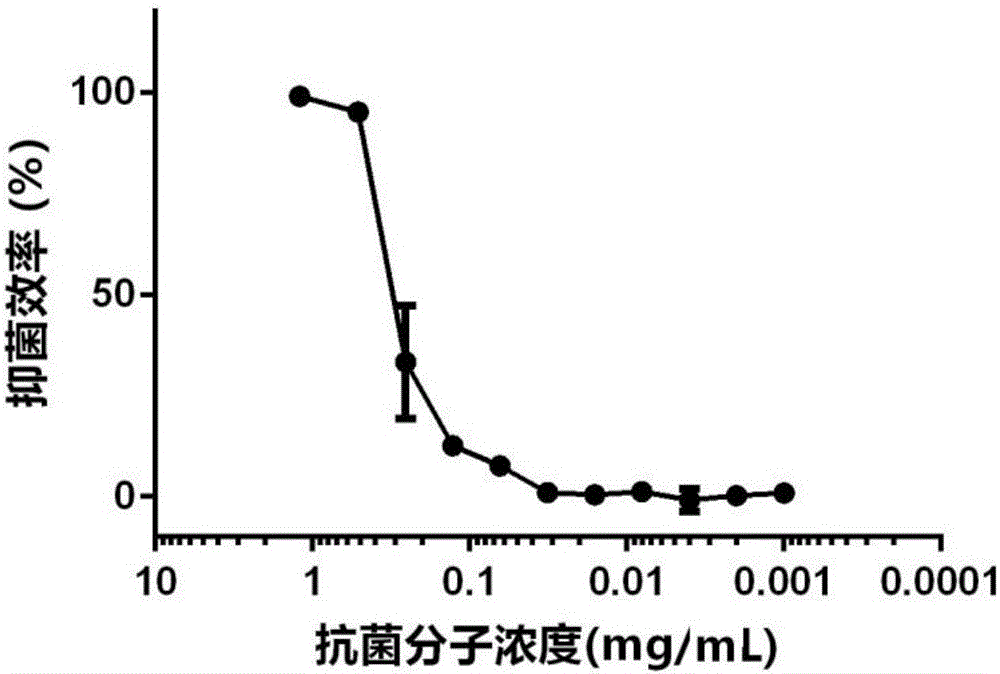High polymer quaternary ammonium salt antibacterial agent preparation method and application
A technology of antibacterial agents and quaternary ammonium salts, applied in botany equipment and methods, applications, biocides, etc., can solve the problems of high cost, complicated preparation process, poor thermal stability and processing performance, and achieve low cost and high preparation Simple process and good stability
- Summary
- Abstract
- Description
- Claims
- Application Information
AI Technical Summary
Problems solved by technology
Method used
Image
Examples
Embodiment 1
[0017] Dissolve 1 g of polyethyleneimine in 5 mL of tetrahydrofuran, and dissolve 2 mL of short-chain halogenated hydrocarbon 1 (bromohexane) in 5 mL of tetrahydrofuran. The polyethyleneimine solution was added dropwise to the hexylbromide solution. Maintain stirring at 50°C for 24h. After the reaction, the product was precipitated with ether, and finally dried under reduced pressure to obtain quaternized polyethyleneimine 1.
Embodiment 2
[0019] Dissolve 1 g of polyethyleneimine in 5 mL of tetrahydrofuran, and dissolve 4 mL of short-chain halogenated hydrocarbon 2 (methyl iodide) in 5 mL of tetrahydrofuran. Add the polyethyleneimine solution dropwise into the iodomethane solution, and keep stirring at 50°C for 24h. After the reaction, the solvent tetrahydrofuran and unreacted methyl iodide were removed by rotary evaporation, and finally the quaternized polyethyleneimine 2 was obtained by drying under reduced pressure.
experiment example 3
[0021] The antibacterial agent (quaternized polyethyleneimine 1) prepared in Example 1 of the present invention was subjected to a bacterial liquid co-culture antibacterial experiment. The bacteria used for detection was Escherichia coli ATCC 25922. In this experiment, the equal concentration dilution method was used to determine the minimum inhibitory concentration. The specific method is as follows: the material to be tested is dissolved in deionized water with an initial concentration of 4096 μg / mL. Then, dilute to 1 μg / mL in a 96-well plate. In the experimental group, 70 μg of different concentrations of antibacterial materials were added to each well. 70 μg of deionized water was added to the control group. Dilute the cultured Escherichia coli to about 2×10 6 CFU / mL. Subsequently, 70 μg of culture medium containing bacteria was added to each well of the experimental group and the control group. Incubate the 96-well plate with slight shaking at 37°C for 20 hours, and ...
PUM
 Login to View More
Login to View More Abstract
Description
Claims
Application Information
 Login to View More
Login to View More - R&D
- Intellectual Property
- Life Sciences
- Materials
- Tech Scout
- Unparalleled Data Quality
- Higher Quality Content
- 60% Fewer Hallucinations
Browse by: Latest US Patents, China's latest patents, Technical Efficacy Thesaurus, Application Domain, Technology Topic, Popular Technical Reports.
© 2025 PatSnap. All rights reserved.Legal|Privacy policy|Modern Slavery Act Transparency Statement|Sitemap|About US| Contact US: help@patsnap.com


